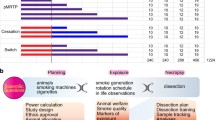Abstract
Elastase and chronic cigarette smoke exposure animal models are commonly used to study lung morphologic and functional changes associated with emphysema-like airspace enlargement in various animal species. This chapter describes the rationale for using these two models to study mechanisms of COPD pathogenesis and provides protocols for their implementation. E-cigarettes are an emerging health concern and may also contribute to lung disease. Accordingly, approaches to study e-cigarette vapors are provided. This chapter also includes methods and tools necessary to assess lung morphologic and functional changes in animals with emphysema-like airspace enlargement.
Access this chapter
Tax calculation will be finalised at checkout
Purchases are for personal use only
Similar content being viewed by others
References
Lucey EC, Goldstein RH, Stone PJ, Snider GL (1998) Remodeling of alveolar walls after elastase treatment of hamsters. Results of elastin and collagen mRNA in situ hybridization. Am J Respir Crit Care Med 158(2):555–564
Snider GL, Lucey EC, Stone PJ (1986) Animal models of emphysema. Am Rev Respir Dis 133(1):149–169
Wright JL, Churg A (1990) Cigarette smoke causes physiologic and morphologic changes of emphysema in the Guinea pig. Am Rev Respir Dis 142(6 Pt 1):1422–1428
Takubo Y, Guerassimov A, Ghezzo H, Triantafillopoulos A, Bates JH, Hoidal JR et al (2002) Alpha1-antitrypsin determines the pattern of emphysema and function in tobacco smoke-exposed mice: parallels with human disease. Am J Respir Crit Care Med 166(12 Pt 1):1596–1603
Fallica J, Das S, Horton M, Mitzner W (2011) Application of carbon monoxide diffusing capacity in the mouse lung. J Appl Physiol (1985) 110(5):1455–1459
Weibel ER, Hsia CC, Ochs M (2007) How much is there really? Why stereology is essential in lung morphometry. J Appl Physiol (1985) 102(1):459–467
Ochs M (2006) A brief update on lung stereology. J Microsc 222(Pt 3):188–200
Vasilescu DM, Klinge C, Knudsen L, Yin L, Wang G, Weibel ER et al (2013) Stereological assessment of mouse lung parenchyma via nondestructive, multiscale micro-CT imaging validated by light microscopic histology. J Appl Physiol (1985) 114(6):716–724
Guerassimov A, Hoshino Y, Takubo Y, Turcotte A, Yamamoto M, Ghezzo H et al (2004) The development of emphysema in cigarette smoke-exposed mice is strain dependent. Am J Respir Crit Care Med 170(9):974–980
Podowski M, Calvi C, Metzger S, Misono K, Poonyagariyagorn H, Lopez-Mercado A et al (2012) Angiotensin receptor blockade attenuates cigarette smoke-induced lung injury and rescues lung architecture in mice. J Clin Invest 122(1):229–240
Gosker HR, Langen RC, Bracke KR, Joos GF, Brusselle GG, Steele C et al (2009) Extrapulmonary manifestations of chronic obstructive pulmonary disease in a mouse model of chronic cigarette smoke exposure. Am J Respir Cell Mol Biol 40(6):710–716
Churg A, Wright JL (2009) Testing drugs in animal models of cigarette smoke-induced chronic obstructive pulmonary disease. Proc Am Thorac Soc 6(6):550–552
Ni K, Serban KA, Batra C, Petrache I (2016) Alpha-1 antitrypsin investigations using animal models of emphysema. Ann Am Thorac Soc 13(Suppl 4):S311–S316
Yamato H, Sun JP, Churg A, Wright JL (1997) Guinea pig pulmonary hypertension caused by cigarette smoke cannot be explained by capillary bed destruction. J Appl Physiol (1985) 82(5):1644–1653
Antunes MA, Rocco PR (2011) Elastase-induced pulmonary emphysema: insights from experimental models. An Acad Bras Cienc 83(4):1385–1396
Sawada M, Ohno Y, La BL, Funaguchi N, Asai T, Yuhgetsu H et al (2007) The Fas/Fas-ligand pathway does not mediate the apoptosis in elastase-induced emphysema in mice. Exp Lung Res 33(6):277–288
Luthje L, Raupach T, Michels H, Unsold B, Hasenfuss G, Kogler H et al (2009) Exercise intolerance and systemic manifestations of pulmonary emphysema in a mouse model. Respir Res 10:7
Cohen A, George O (2013) Animal models of nicotine exposure: relevance to second-hand smoking, electronic cigarette use, and compulsive smoking. Front Psych 4:41
Yee BE, Ahmed MI, Brugge D, Farrell M, Lozada G, Idupaganthi R et al (2010) Second-hand smoking and carboxyhemoglobin levels in children: a prospective observational study. Paediatr Anaesth 20(1):82–89
Harris AC, Mattson C, Lesage MG, Keyler DE, Pentel PR (2010) Comparison of the behavioral effects of cigarette smoke and pure nicotine in rats. Pharmacol Biochem Behav 96(2):217–227
Benowitz NL, Jacob P 3rd (1984) Daily intake of nicotine during cigarette smoking. Clin Pharmacol Ther 35(4):499–504
Brody AL, Mandelkern MA, London ED, Khan A, Kozman D, Costello MR et al (2011) Effect of secondhand smoke on occupancy of nicotinic acetylcholine receptors in brain. Arch Gen Psychiatry 68(9):953–960
Brody AL, Mandelkern MA, London ED, Olmstead RE, Farahi J, Scheibal D et al (2006) Cigarette smoking saturates brain alpha 4 beta 2 nicotinic acetylcholine receptors. Arch Gen Psychiatry 63(8):907–915
Kang MJ, Lee CG, Lee JY, Dela Cruz CS, Chen ZJ, Enelow R et al (2008) Cigarette smoke selectively enhances viral PAMP- and virus-induced pulmonary innate immune and remodeling responses in mice. J Clin Invest 118(8):2771–2784
Das S, MacDonald K, Chang HY, Mitzner W (2013) A simple method of mouse lung intubation. J Vis Exp 21(73):e50318. PMC3639692
Acknowledgments
Funding sources are RO1HL077328 (IP) and 2014 Alpha-1 Foundation Gordon L. Snider Scholar Award (KAS).
Author information
Authors and Affiliations
Corresponding author
Editor information
Editors and Affiliations
Rights and permissions
Copyright information
© 2018 Springer Science+Business Media, LLC, part of Springer Nature
About this protocol
Cite this protocol
Serban, K.A., Petrache, I. (2018). Mouse Models of COPD. In: Alper, S., Janssen, W. (eds) Lung Innate Immunity and Inflammation. Methods in Molecular Biology, vol 1809. Humana Press, New York, NY. https://doi.org/10.1007/978-1-4939-8570-8_25
Download citation
DOI: https://doi.org/10.1007/978-1-4939-8570-8_25
Published:
Publisher Name: Humana Press, New York, NY
Print ISBN: 978-1-4939-8569-2
Online ISBN: 978-1-4939-8570-8
eBook Packages: Springer Protocols




